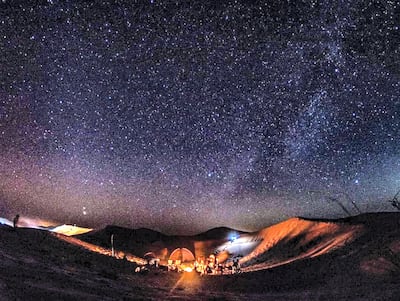Al Quaa, aka the “Milky Way spot”, is one of the most naturally dark patches of desert in the UAE. As such, it affords stellar views of the night skies, as well as constellations, planets and shooting stars, plus celestial events such as the Perseids meteor shower and rare supermoons.
Here’s what you need to know if you’re planning a trip.
What will I see at Al Quaa?
Stars galore, as well as specific constellations and planets (that can be identified via apps such as SkyView Lite), and the odd shooting star.
The spot is most famous for the views it offers of the Milky Way, the galaxy that the Earth’s solar system is part of. To the naked eye, the Milky Way shows up as a band of light that is actually the starlight emitted from the clusters that form the galaxy. You don’t need a telescope or any other equipment to see this on a clear night.
Above all, say those in the know, the spot is a peaceful yet humbling reminder of the universe at large.
“It’s amazing to sit under the night sky and gaze at the stars,” says photography enthusiast Winn W Gomez, a BIM consultant with Autodesk. “You can occasionally see a shooting star or see the ISS [International Space Station] go by. Since the place is so silent and open, you are immediately in awe of the expanse of the universe."
Fellow stargazer Juan Carlos Dela Cruz loves the fact that the spot makes for a “relaxing escape from the hustle and bustle of the city. It's like reconnecting with nature and the universe,” says the clinical nurse facilitator, adding: “It reminds me that the UAE has a lot to offer. And the best thing about this one is that it's absolutely free of charge.”
Best time to go and getting there
Darkness is key. A new moon night with clear skies is the best time to visit Al Quaa, where you can also camp overnight in the cooler months. Avoid full moon nights if stargazing is high on your agenda as the lunar light can obstruct views of the Milky Way and other constellations.
“A look at the weather forecast will help you make a better call,” says Chitra Nair, lead recruiter at Gutteridge, Haskins and Davey. “A foggy day will reduce visibility of sand dunes and make the desert a little less navigable.
You don’t need a 4X4 to reach Al Quaa unless you’re planning to go off-roading amid the dunes. If you are using a regular car, just stay in the packed sand road area.
Where is Al Quaa?
Al Quaa is located at 23.604633,54.750256 and is an approximately 90-minute drive from Abu Dhabi city towards Al Ain.
Look out for a large roundabout when you’re nearing the location to find the gated spot that’s just behind it on the dirt road.
As Veronika Hirsh, a yoga teacher at Breathe Yoga Studio in Abu Dhabi, puts it: “It sounds like a lot to drive 125 kilometres just to go stargazing, but it is worth the drive. The Milky Way looked amazing when I visited. I've never seen so many stars before.”
While stars are technically visible from any other open expanse, Gomez says: “Al Quaa site is the darkest place in the UAE, far away from city lights. Another spot is the Al Showka Dam, but it’s lit by flight paths, whereas with no artificial lights around at Al Quaa, on a clear night you can see a million stars.”
Hirsh says she’s a big fan of camping in the Liwa desert as well.
Equipment for stargazing
The galaxy and various constellations are visible to the naked eye, but if you want to capture the sights, a smartphone camera will not suffice (also, mobile phone reception can be sketchy in some patches).
Gomez, who first visited Al Quaa with a group of photographers for a workshop run by Nikon, says: “It was quite the learning experience, from capturing nothing to capturing the Milky Way. A DSLR/mirrorless camera is useful. Bring a fast lens and mount your camera on a tripod. The Milky Way is captured with a long exposure, so be sure not to shake your camera. Apps that allow you to manually set up the camera will also help. If you stay the night, you can also capture some breathtaking views of the sunrise amongst the dunes.”
Dos and don’ts
· Do carry flash lights or a small floodlight should you want to walk around in the dark.
· Don’t use too many unnatural lights, especially when others are trying to stargaze or take photographs.
· Do choose a spot away from the main road to avoid the sound of cars and flash of headlights.
· Don't go during a full moon, you won't see much.
· Do carry water and food as the closest petrol station is almost 15 minutes away.
· Do not litter. Carry extra garbage bags to cart trash to a spot where you can dispose of it responsibly.
· Do carry warm clothes if you plan to stay past sunset as the temperature drop is drastic in the cooler months.
· Do arrive early and set up if you want to do a photo shoot.
· Don't go off-roading alone and without a 4X4.
· Do take a blanket so you can stargaze lying down or use a chair so you don't strain your neck.
· Do make your camp next to your car so if a 4x4 comes by, it won't run your tent over.
· Don’t be loud, so others can enjoy the experience, too.
· Do bear in mind there are no toilet facilities available.
· Do carry a proper camera if you want to take pictures of the stars or the Milky Way itself; it won't work using a phone's camera, you will only see darkness.







